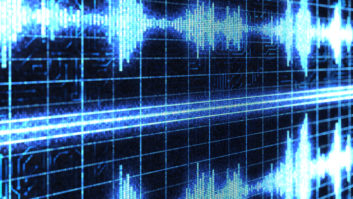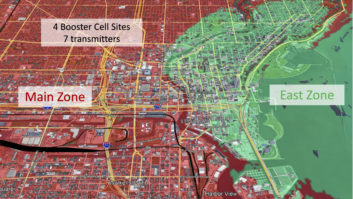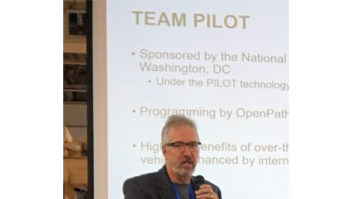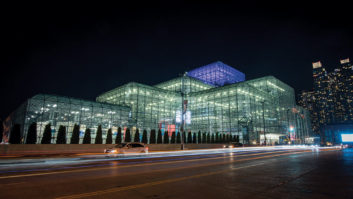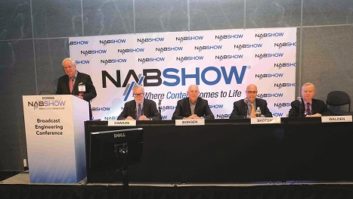If the FCC ever allows broadcasters on the U.S. AM band to use all-digital modulation, some observers worry about the interference consequences. Now there’s new research on this subject to add to the discussion.
David Layer, senior director, advanced engineering of the National Association of Broadcasters’ Technology Department, released findings in April of a comprehensive testing program undertaken by NAB Labs (now renamed Pilot) to determine how all-digital signals would affect co-channel listening if stations migrate to all-digital.

A comparison of Phase 1 (no added RF noise) and Phase 2 (with added RF noise). Layer said this shows how the added RF noise, which simulates a realistic listening environment, masks the additional co-channel interference generated by an all-digital AM signal.

This graph is all Phase 2, showing performance for three received signal levels: –56 dBm (corresponding to 5 mV/m), –64 dBm (corresponding to 2 mV/m) and –76 dBm (corresponding to 0.5 mV/m). The NAB has been conducting extensive field testing into various aspects of all-digital HD Radio on the AM band since late 2012, beginning with WBCN(AM), 1660 kHz, station in Charlotte, N.C., formerly owned by CBS and now by Beasley. Those tests were conducted on a 10 kW day/1 kW night nondirectional facility that demonstrated very promising daytime results, according to proponents.
Since then, additional field tests have been conducted on WBT and WNCT in Charlotte, N.C.; WD2XXM Columbia, Md.; WDGY Hudson, Wis.; KTUC Tucson, Ariz.; KRKO and KKXA Everett, Wash.; and WSWW Charleston, W.Va.
Layer told attendees at the NAB Show that all exhibited similar impressive daytime performance in the all-digital mode. Both day and night tests were done on most of those stations. Several employed complicated multi-tower directional antenna systems.
All-digital AM nighttime performance was not as good, and additional work and study will be needed to assess how and when all-digital AM can best be used at night.
Layer said that all-digital on AM offers several important benefits and improvements over the legacy analog mode. Those include significantly better audio quality, similar to analog FM stereo, as-good or better coverage than the analog-only signal (during daytime operation), more immunity to noise and interference and potential support for data and multi-casting. Further, it is receivable on both new and existing HD Radio receivers.
He conceded that the hybrid AM digital MA-1 mode has not been all that successful. It is being used by only about 200 U.S. stations, and many that had converted have since turned hybrid AM HD off, because of such issues as adjacent-channel interference, excessive blending and annoying drop-outs in reception. He suggested that these challenges become less problematic and less of a concern with the MA-3 all-digital mode.
HD Radio owner DTS Inc. reports there are close to 30 million HD Radio receivers in the hands of consumers and that the number continues to grow steadily. Plus, about 50 percent of new cars being sold include HD Radio receivers. HD Radio continues to be “discovered by accident” every day by millions of new car buyers.

Test receivers included an Insignia ITR tabletop HD Radio receiver; after-market car radios including Kenwood and Pioneer HD car radios as well as a Clarion analog-only car radio; and a Delphi factory installed OEM HD Radio car unit. Layer said that Cavell, Mertz & Associates engineers Dan Ryson and Mike Rhodes collaborated to construct the hardware test platform used for the lab tests last year. (Ryson has since taken a position with CBS.)
It consisted of two separate racks. One contained the RF equipment including three low-power HD exciter/transmitters, HD exporters, RF combiners, splitters and attenuators, five test receivers, a spectrum analyzer and other associated test equipment. The other housed the audio equipment including audio router, automation equipment, audio processors, control computer, audio analyzers and other measurement equipment.
Test receivers included an Insignia ITR tabletop HD Radio receiver; three after-market car radios including Kenwood and Pioneer HD car radios as well as a Clarion analog-only car radio; and a Delphi factory installed OEM HD Radio car unit.
A series of co-channel interference tests were performed using four different modes and varying signal strengths. The frequency 890 kHz was used as the test frequency to measure the resulting interference and noise degradation generated from the undesired all-digital signal to the desired signals received by the test receivers.
Because the foremost concern of existing analog stations is possible increased interference from stations that may choose to run all-digital, the primary focus of these tests was directed on all-digital interference into analog listening.
Layer stated categorically that first-adjacent-channel interference that is so troublesome with the hybrid and analog modes of operation will be all but eliminated with the reduced-bandwidth mode of all-digital. The occupied bandwidth reduces from 30 kHz (hybrid MA-1) to 10 kHz (all-digital MA-3, reduced bandwidth mode), which is less than the bandwidth used by most existing analog AM stations.
“Theory predicts an all-digital signal will elevate the co-channel noise floor 9 dB higher than a comparable analog signal in a noise-free environment,” he said.
The simulations were performed in two phases. The first considered the ideal “noise-free” environment. Phase two evaluated “real-world” noisy environments by adding RF white noise.
Both phases confirmed expectations, Layer said. In the noise-free case, the induced noise differential (due to all-digital or analog undesired signals) remained essentially constant at about 10 dB for desired-to-undesired signal strength ratios from zero dB to about 40 dB. From 40 to 60 dB D/U, the difference reduced gradually to zero dB. (See noise graphs.)
In the “real world” case, when testing the desired signal at a 46 dB D/U ratio, which for this test corresponded to a 5 mV/m primary contour analog signal strength, only a 3 dB decrease in SNR was noted when a co-channel all-digital undesired signal was turned on, compared to a co-channel analog undesired signal. This remained the same at a much weaker 26 dB D/U ratio, for the weaker signal strength corresponding to the 0.5 mV/m contour. That was the worst-case measurement for only one of the five tested receivers. The other four receivers averaged about a 1.5 dB noise degradation increase at this same operating point.
Layer played a number of representative audio recordings of the lab test results produced by several of the test receivers. The character of background digital noise was more constant than analog, but seemed less annoying than the “bursting” nature of analog modulation interference. He also played similar recordings obtained during field testing, with similar results.
The relatively small increases of background noise contributed by all-digital signals will likely be mostly masked by the ambient noise floors already present in the listening environment of most areas. The test project concluded that “interference concerns of all-digital signals into existing analog stations should not be an impediment to the rollout of all-digital.”
Subscribers to Radio World Engineering Extra will read the full test results in the June 15 issue of RWEE.
Tom McGinley is Radio World technical advisor and a longtime broadcast engineer. Comment on this or any story to [email protected].





